Japanese architect and designer, Fumihiko Maki won the Wolf Award for the Arts and the Pritzker Prize for his work, which often explores pioneering uses of new materials and fuses the cultures and traditions of East and West civilizations.
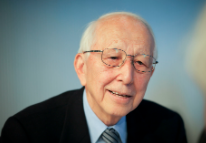
Image source:https://search.creativecommons.org/photos/1a2d02a2-8c4a-443e-9385-ff1a95f167b5 by jeanbaptisteparis
The Most Significant Events In The Author’s Life
Fumihiko Maki was born in 1928 in Tokyo, Japan. He studied architecture at University of Tokyo (among his professors was Kenzo Tange) where he graduated in 1952. He continued his training in the United States at Cranbrook Academy of Art (M.Arch) and Harvard University Graduate School of Design (M.Arch). Prior to returning to Tokyo in 1965 to open his own firm, Maki worked in the offices of SOM – Skidmore, Owings & Merrill and Sert Jackson & Associates, as well as, the campus planning office of Washington University in St. Louis. Maki has maintained an active interest in education while continuing to grow his 45-person practice. While living in the United States, he taught architecture and urban design at Harvard and Washington University. After returning to Japan in 1965, he became a professor at Tokyo University, where he taught architecture and published several books until 1987. In Tokyo, he also opened the studio Maki & Associates, a small structure that prefers to collaborate with major groups depending on the size of the projects. Maki has lectured extensively in Japan, the United States and Europe.

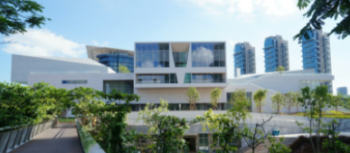
Images source: https://www.archdaily.com/885148/shenzhen-sea-world-culture-and-arts-center-maki-and-associates-not-ready
Maki has been honored by many of the professions’ highest accolades, including the Wolf Prize in 1988, the Thomas Jefferson Medal in Architecture in 1990, the Gold Medal of the UIA in 1993, the Arnold Brunner Prize from the American Academy of Arts and Letters in 1999, and the Praemium Imperiale from the Japan Arts Association in 1999. Acknowledging Maki’s commitment to master planning and his profound understanding of physical, social, and historic conditions involved in this discipline, Harvard University awarded him the Prince of Wales Prize in Urban Design in 1993. Among Maki’s many distinctions, there is the Pritzker Prize, which is considered the “Nobel Prize for Architecture” awarded to Maki in 1993. He is the second Japanese architect who received this recognition after his teacher Kenzo Tange, who had received it in 1987. In 2011, the American Institute of Architects honored Maki with its highest accolade, the AIA Gold Medal.
Info source: http://www.maki-and-associates.co.jp/firm/index.html
Which Are The Best Known Works Created by The Japanese Architect?
- The Spiral Building (Tokyo, 1985)
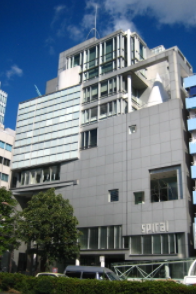
Image source: https://search.creativecommons.org/photos/d93414b7-cd00-4113-a621-407531912b9a by luisvilla
The Spiral Building, was designed in 1985 for the Walcoal lingerie company and became one of Maki’s best known works. The building is located on Aoyama Street, one of Tokyo’s most important shopping districts. Within the concept of “fusion between art and life“, in the Spiral Building the Japanese architect manages to combine the use of commercial functions (shops, restaurants, bars) with cultural and artistic activities held in a multi-purpose hall (theater, dance, concerts). In fact, he said that “In this building I wanted to represent the chaos of the city and for this reason, I took the typical elements of modern architecture, such as cube, cone and the hemisphere and I combined them in an integral way“. At first glance, the building seems to resemble the distinctive style of architecture of Richard Meier: the white color, the use of overlapping patterns and geometric shapes, the aluminum panels and the use of a wavy volume in the façade.
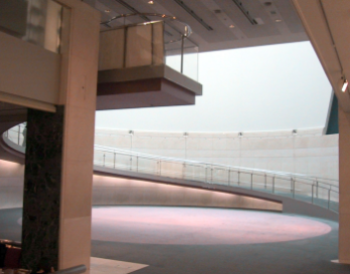
Image source: https://en.wikipedia.org/wiki/Spiral_(building)#/media/File:Spiral_House_01.jpg
Inside the building there is also a reference to Peter Eisenman, to the deconstruction and recomposition of the design elements. A different matter is the interior of the building, characterized by a spatial complexity resulting from an ordered succession of spaces. At the entrance is a large room dominated by a café. On the right, there is a corridor that leads to a series of platforms that can be seen rising from the façade as a series of staggered windows, with no apparent function besides seating a few chairs to look at the street. On the opposite side, near the coffee area, there is another long corridor that leads to the most important space of the building, from which the building itself takes its name. It is a 15m spiral ramp positioned under a glass hemisphere that has a symbolic meaning of self-improvement for the architect. The center of the ramp often hosts numerous temporary exhibitions that can be enjoyed three-dimensionally from above.
Info source: http://architecturalmoleskine.blogspot.com/2011/11/fumihiko-maki-spiral-building.html
- Tokyo Metropolitan Gymnasium (Tokyo, 1991)
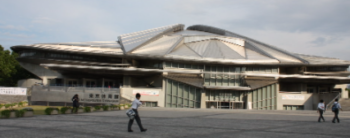
Image source: https://search.creativecommons.org/photos/4a43b2d3-bf4e-4055-ad97-bfac5c4fd7eb by MarkDoliner
Maki has created a futuristic landscape of unexpected contrasts. The Tokyo Metropolitan Gymnasium is a builiding created by architect Fumihiko in 1991 and it is located in front of Sendagaya station in Tokyo’s Shibuya district. This sports center consists of three buildings: a large arena, a smaller sub-arena and a swimming pool, which are joined together by a large stone-paved plaza on two levels. The large arena is the dominant structure in the complex. When viewed from above, the 150-meter-diameter roof is made up of two symmetrical leaf that rest against each other within a circle. The entire roof surface is covered by narrow strips of aluminum that guarantee that part of the roof reflects the sun’s rays at any time during a sunny day. The citizens of the city of Tokyo are not very happy with the structure because they say it looks like a spaceship or a samurai helmet. The structure is definitely open to many different interpretations because its shape is not based on a recognizable architectural style. Whether you find that the stadium is visually pleasing or not, you need to give the architect a certain level of creativity.
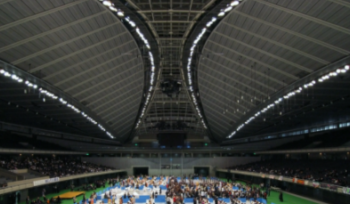
Image source:https://search.creativecommons.org/photos/5c4f07ee-5a51-4fc4-8049-e516d9229677 by Wiiii
The smaller sub-arena is located southwest of the stadium. The main part of its interior is located below the ground, but its stepped roof protrudes above the square. The ziqqurat structure is covered with blue tiles. Its simple cube shapes are in contrast with the flowing curves of the main arena. The indoor pool is located in a building in the south-western corner of the site. This building is the most conventional aspect of the three structures, being a rectangular shape covered by a slightly curved arched roof. Its most notable feature is a teflon roof perched on top of the walls that are concrete below and the glass block above, allowing a generous amount of sunlight to flood the interior. In contrast to the two arenas, where heavy roofs block the entrance of natural light and close the interior from the sky above, the translucent roof of the pool structure seems to open its interior to the sky above. The Tokyo Metropolitan Gymnasium is intended to be appreciated only by those who have an unceasingly forward-looking orientation.
Info source: http://bento.com/arch/tmg.html
How Can We Identify Maki’s Style Of Design?
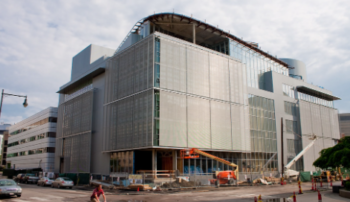
Image source: https://search.creativecommons.org/photos/51399524-dac4-4096-90c5-9e28a205e235 by ToastyKen
Fumihiko Maki calls himself a modernist, unequivocally. He is a student of two cultures, whose fusion of the two influences was highly acclaimed. In addition to the influence of his Japanese and American masters, he strongly resented the great European architects, especially Le Corbusier and Walter Gropius‘ Bauhaus School. Together with many other Japanese architects, he has kept a constant interest in new technologies as part of his design language, often taking advantage of modular building systems. He makes a conscious effort to capture the spirit of a place and an era, producing with each building or complex of buildings, a work that makes full use of all that is currently under his command. Indeed, his buildings are different from many large-scale modernist buildings, however, they are direct, sometimes sober, and made of metal, concrete and glass, the classic materials of the modernist age, but the canonical palette has also been extended to materials such as mosaic tiles, anodized aluminum and stainless steel.
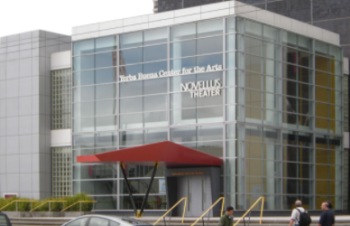
Image source:https://en.wikipedia.org/wiki/Yerba_Buena_Center_for_the_Arts
Instead of a monolithic and imposing space, Maki has created multiple layers of space to invoke a feeling of private courtyards and garden spaces, essential elements for Japanese architecture. This planning incorporates Maki’s theories about the interdependence of the parts and the whole, as he hoped that these small and intimate spaces would combine to create a general sense of community and harmony. He often speaks of the idea of creating “unforgettable scenes” – in fact, settings to accommodate and integrate all kinds of human interaction – as inspiration and starting point for her projects. As said before, he is a student of two cultures. For this reason, Maki recently wrote of his native Tokyo with nostalgia and hope. “Tokyo is the place where I was born, raised and educated, and even in Tokyo I became familiar with some of the few modern architecture that existed in the ’30s in Japan: the white houses of modern pioneers like Kameki Tsuchiura (who was a student of Frank Lloyd Wright when the latter was in Japan to design the old Imperial Hotel), Sutemi Horiguchi and Antonin Raymond“.
Info source:
